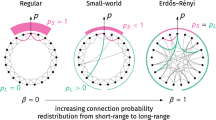Abstract
Given a network where each element has a small number of connected elements, the randomization of connections with small probabilities results in networks with a high broadcast speed. Such networks belong to the class of so-called small-world networks. Analyses indicate that broadcast to all elements of the network is fundamentally different from the average transmission speed. Networks with 10% randomness give the fastest broadcast speeds with no dependence on the position of the initial transmission source.
Similar content being viewed by others
Explore related subjects
Discover the latest articles, news and stories from top researchers in related subjects.References
Watts DJ, Strogatz SH (1998) Collective dynamics of “small-world” networks. Nature 393:440–442
Albert R, Jeong H, Barabási AL (1999) Diameter of the world-wide web. Nature 401:130
Jeong H et al. (2000) The large-scale organization of metabolic networks. Nature 407:651–654
Ballabás B (1985) Random graphs. Academic Press, New York
Ohi N, Maeshiro T (2000) Structural analysis of networks and broadcast speed (in Japanese). ATR Technical Report TR-IS002
Author information
Authors and Affiliations
Corresponding author
About this article
Cite this article
Maeshiro, T., Ohi, N. & Shimohara, K. Analysis of small-world networks with high broadcast speed. Artif Life Robotics 6, 163–166 (2002). https://doi.org/10.1007/BF02481260
Received:
Accepted:
Issue Date:
DOI: https://doi.org/10.1007/BF02481260




